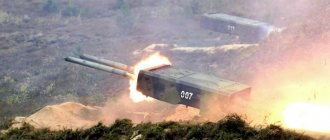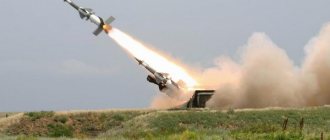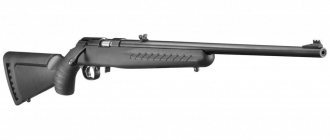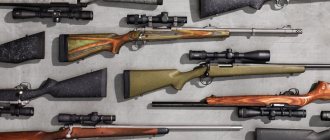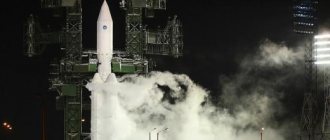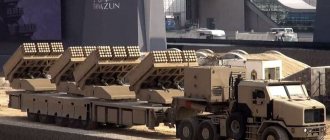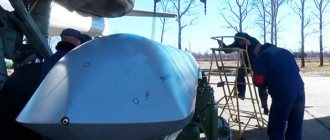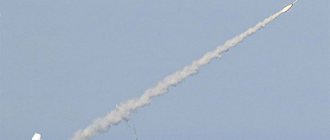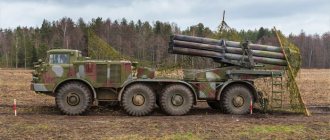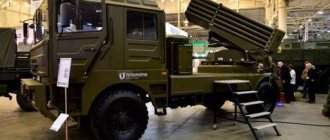MLRS 9K58 "Smerch" is a Soviet and Russian multiple launch rocket system of 300 mm caliber. Since December 2016, the replacement of the Smerch MLRS and the Grad MLRS with the MLRS of the Tornado family began, where the combat vehicles are generally designed similarly to their predecessors, but are equipped with GLONASS navigation and a new computerized fire control system. GLONASS is also used in guided missiles for the Tornado-S MLRS, which is confirmed by experts from the International Institute for Strategic Studies and the manufacturer. The Smerch MLRS can use a special missile that fires a UAV over the target for reconnaissance and fire adjustment within 20-30 minutes.
MLRS 9K58 “Smerch” – video
Composition of the complex
– combat vehicle (BM) 9K58; – transport-loading machine 9T234−2; – rockets; – training aids 9F827; – a set of special arsenal equipment and tools 9F819; – complex of automated fire control equipment (KSAUO) 9С729М1 “Slepok-1”; – vehicle for topographic survey 1Т12−2М; – direction-finding meteorological complex 1B44.
History of creation
The Smerch multiple launch rocket system was developed in the USSR by specialists from TulgosNIItochmash (then NPO Splav, and now JSC NPO Splav, Tula) under the leadership of chief designer Gennady Alekseevich Denezhkin, as well as related enterprises. Before its development in 1990 by China, the WS-1 was the longest-range system.
The artillery unit is mounted on a modified MAZ-79111 or MAZ-543M truck chassis. For India, a combat vehicle version was created based on the Tatra 816 6ZVR8T10x10.1 R/41T off-road truck.
Preparing the Smerch for battle after receiving target designation takes three minutes; a full salvo is fired within 38 seconds. After firing, the battery is ready to march in one minute, which allows you to quickly escape from the enemy's retaliatory strike.
Ammunition
9M55K - 300-mm rocket with a 9N139 cassette warhead (MC) with 9N235 fragmentation warheads (FME). Contains 72 combat elements (CU), each carrying 96 ready-made heavy fragments, designed to destroy unarmored vehicles, and 360 ready-made light fragments, intended to destroy enemy personnel in places where they are concentrated; in total - up to 32832 fragments. The affected area of the element is 300–1100 m². Armor penetration at a distance of 10 m is 5-7 mm, at a distance of 100 m - 1-3 mm. 12 shells contain 393984 finished fragments. Most effective in open areas, steppes and deserts. Serial production of 9M55K (and 9M55K-IN - with inert BE equipment) began in 1987. Delivered to Algeria and India.
9M55K1 - a rocket with a 9N142 cluster warhead (KGCH) with self-aiming combat elements (SPBE). The cassette warhead carries 5 SPBE "Motiv-3M" (9N349), equipped with dual-band infrared coordinators that search for the target at an angle of 30°. Each of them is capable of penetrating 70 mm of armor at an angle of 30° from a height of 100 meters. Suitable for use in open areas, steppes and deserts; use in the forest is almost impossible; use in the city is difficult. Designed to destroy groups of armored vehicles and tanks from above. Tests completed in 1994 and accepted in 1996. By order of the Minister of Defense No. 372 of October 13, 1996, the 9M55K1 projectile was adopted by the Russian Army. Delivered to Algeria.
9M55K4 - a rocket with the 9N539 KGC for anti-tank mining of terrain. Each projectile contains 25 PTM-3 anti-tank mines with an electronic proximity fuse; in just one salvo of the installation there are 300 anti-tank mines. Designed for rapid, remote placement of anti-tank minefields in front of enemy military equipment units located at the attack line or in the area where they are concentrated.
9M55K5 - a rocket with a KGC 9N176 with cumulative fragmentation combat elements (KOBE). The cassette warhead contains 646 combat elements with a length of 118 mm, or 588 elements with a length of 128 mm, weighing 240 g each, and having a cylindrical shape. Elements with a length of 118 mm are capable of normally penetrating up to 120 mm of homogeneous armor, and elements with a length of 128 mm can penetrate up to 160 mm. Maximum effective against motorized infantry on the march, located in armored personnel carriers and infantry fighting vehicles. A total of 12 shells contain 7752 or 7056 combat elements. Designed to destroy open and hidden manpower and lightly armored military equipment.
9M55F - a rocket with a detachable high-explosive fragmentation warhead. Designed to destroy manpower, unarmored and lightly armored military equipment in places where they are concentrated, to destroy command posts, communication centers and infrastructure facilities. It was adopted by the Russian Army in 1992, and has been in mass production since 1999. Delivered to India.
9M55S - a rocket with a thermobaric warhead 9M216 "Excitement". The explosion of one shell creates a thermal field with a diameter of at least 25 m (depending on the terrain). The field temperature is over +1000 °C, the lifetime is at least 1.4 s. Designed to destroy manpower, open and hidden in open fortifications and unarmored and lightly armored military equipment. It is most effective in the steppe and desert, in a city located on non-hilly terrain. Testing of the ammunition was completed in 2004. By Order of the President of the Russian Federation No. 1288 of October 7, 2004, the 9M55S was adopted by the Russian Army.
9M528 - a rocket with a high-explosive fragmentation warhead. Contact fuse, instant and delayed action. Designed to destroy manpower, unarmored and lightly armored military equipment in places where they are concentrated, destroying command posts, communication centers and infrastructure facilities.
9M534 is an experimental missile with a small-sized reconnaissance unmanned aerial vehicle (UAV) of the Tipchak type. Designed to conduct operational reconnaissance of targets within twenty minutes. In the target area, the UAV descends by parachute, scanning the situation and transmitting information on the coordinates of reconnaissance targets to the control complex at a distance of up to 70 km, for quickly making a decision to destroy the reconnaissance object.
9M542 is a guided missile with a detachable high-explosive fragmentation or cluster warhead with a firing range of up to 120 km.
Ammunition developments
In 2012, the passport and advertising passport for the 9m542 extended-range guided missile, developed for a foreign customer, were approved. Minimum range 40 km, maximum range 120 km. Length 7600 mm, total weight 820 kg, warhead weight 150 kg, explosive weight 70 kg, loaded with 500 pieces of finished fragments weighing 50 g. In 2016, it was announced that the Tornado-S MLRS would be equipped with these projectiles.
Combat vehicle options
9A52 - basic version on the MAZ-79111 chassis
9A52B - combat vehicle of the automated control system for MLRS formations 9K58B
9A52-2 combat vehicle on a modified MAZ-543M truck chassis
9A52-2 - combat vehicle on the MAZ-543M chassis of the 9K58 MLRS complex
9A52-2K - command combat vehicle on the MAZ-543M chassis of the modernized 9K58 MLRS complex
9A52-2T - a combat vehicle on the Tatra chassis of the modernized 9K58 MLRS complex
9A52-4 - lightweight combat vehicle MLRS "Kama" on the KamAZ chassis
9A53 is a combat vehicle of the 9K512 Uragan-1M MLRS complex with an installed transport and launch container with 300 mm rockets.
9A54 - combat vehicle of the modernized 9K515 "Tornado-S" system
Transport-loading machine 9T234-2
Options for transport-charging machines
9T234 - transport-loading vehicle BM 9A52 on the MAZ-79112 chassis
9T234-2 - transport-loading vehicle BM 9A52-2 on the MAZ-543A chassis
9T234-2T - transport-loading vehicle BM 9A52-2T on the Tatra chassis
9T234-4 - transport-loading vehicle BM 9A52-4 on a KamAZ chassis
9T255 - transport-loading vehicle BM 9A54
Comparison with analogues
According to the conclusion of IISS experts in the MilitaryBalance 2017 reference book, the Smerch-M MLRS and its improved version Tornado-C are superior in range to the US-made NATO MLRS.
"Motovilikha", or "Smerch" on the "Tatr"
In the 90s, the Smerch MLRS was one of the most powerful and effective systems in its class. This reputation was somewhat spoiled by the special “rocket” four-axle chassis, bulky and complex. An alternative could be to use the base of a simpler off-road vehicle, unified with transport vehicles - this would reduce operating costs. Meeting the wishes of the customer, specialists from Motovilikha Plants created a version of the Smerch on the Czech Tatra chassis.
As is known, the basic version of the Smerch MLRS uses a Belarusian and Russian-made chassis: the 9A52 launcher is based on a four-axle MAZ-79111 or MAZ-543M chassis, and the other vehicles of the complex are based on three-axle Ural and KamAZ vehicles. The Indian customer was not satisfied, first of all, with the launcher chassis - it was considered too bulky and difficult to operate. In search of a suitable base, the Indian military turned to its long-time supplier, the Czech Republic. The Indian Army operates several thousand two-, three- and four-axle vehicles of this brand, and Tatra 815 vehicles have been produced under license since 1986. It was a small matter - to “join” the manufacturers of the chassis and the MLRS.
Development
Considering the considerable potential need of the Indian Army for new MLRS, the Russian side met the customer halfway. In 1999, a delegation from Rosoboronexport arrived in Kopřivnice. Russian and Czech experts came to a unanimous opinion: the standard four-axle Tatra 815 chassis will not withstand the weight of the Smerch artillery unit. The solution proposed by the Tatra designers turned out to be extremely simple - add a fifth axle. In the shortest possible time, two prototypes of ten-wheeled chassis were produced in Kopřivnice. The basis was not the standard 815 model, but its improved version “Tatra” 816 LIWA (later known as model 815-6), created in the 90s by order of the United Arab Emirates. In 1996-1998, 1,127 vehicles of this type in various versions were delivered to the UAE.
Car "Tatra" 816 LIWA armyrecognition.com
The Tatra 816 LIWA was equipped with Western-made components - a German Deutz diesel engine and an American Twin Disc automatic transmission. A special feature of the model was the presence of a voluminous behind-the-cab compartment (nicknamed na), which housed the engine and transmission oil cooling systems.
Both five-axle prototypes went to Russia already in 1999, where, after the installation of artillery units, they underwent sea trials. The next round of testing took place in 2002 at the customer’s premises. In India, Tatras have proven themselves to be excellent in a variety of climatic conditions, including in the highlands (at an altitude of up to 4000 m). In 2003, Russian-Indian negotiations began on the supply of Smerchs on the Tatra chassis. The Czech company acted as a subcontractor in the supply of basic machines, and was also responsible for personnel training, after-sales service and the supply of spare parts.
Design
In the proprietary nomenclature, the five-axle chassis received the index 815-6ZVR8T 41 340 10×10.1R. Actually, we are talking about not one, but two chassis options: 815-6ZVR8T 41 340 10×10.1R/51T and 815-6ZVR8T 44 340 10×10.1R/50T, differing in maximum permissible weight (41 t for the first option and 44 t - for the second). The first option serves as a chassis for the 9A52-2T launcher (a standard Smerch artillery unit with twelve guides is installed), and the second - for the 9T234-2T transport-loading vehicle. The latter carries twelve missiles and is equipped with a hydraulic crane. Tatra workers nicknamed the five-axle chassis “Motovilikha”, since the MLRS itself is produced by the public joint stock company “Motovilikha Plants” in Perm.
Launcher 9A52-2T armyrecognition.com
Both modifications are equipped with a diesel engine (as indicated by the letter Z in their designations). The eight-cylinder V-shaped liquid-cooled engine BF 8M 1015C has a displacement of 15.9 liters and a maximum power of 400 kW, but for the Indian Smerchs it is derated to 340 kW. The first batches of cars were equipped with a six-speed Twin Disc automatic transmission TD 61-1175, but later they began to install the more advanced TD 61-1189.
Behind the cabin there is an additional compartment in which the engine cooling radiator and air filter are installed, and the intercooler takes the traditional place of the radiator in front of the engine. The front axle suspension is made using leaf springs and telescopic shock absorbers. The third and fourth axles have a suspension on air springs and leaf springs, the fifth - on a combination of air springs and coil springs. The first four axles have a permanent drive, the fifth is activated if necessary. For standard four-axle Tatra vehicles, the first two axles are steerable, and for the five-axle model, the fifth axle is also steerable. This made it possible, despite the increased length, to keep the maneuverability of the vehicle within acceptable limits.
The Emirati Tatra 816 had cabins from the older standard model 815. The Indian chassis used cabins from the Armax family. They are equipped with Slovak Diavia air conditioning systems, as well as independent Breeze heaters.
The artillery unit of the 9A52-2T is identical to the standard Smerch. The same ammunition is used, including 122-mm NAR, intended for training shooting from insert barrels.
Salvo of 122-mm training ammunition NAR Visinger L. Smerč na podvozku Tatra // ATM, 2022, No. 2
Complex
The Smerch MLRS is not only a launcher and heavy equipment, but also a whole complex of support vehicles. For the purpose of unification, the Indians insisted on making them also on the Tatra chassis, but lighter ones. For the command and staff vehicle and the mobile workshop, we chose the three-axle Tatra chassis 815-21NR36 22 230 6×6.1R, and for the weather station and topographic surveyor - the two-axle 815-21NR45 17 230 4×4.1R. Both options are equipped with eight-cylinder air-cooled Tatra T3V-928-1 diesel engines with a power of 230 kW and ten-speed manual transmissions.
Command and staff vehicle Visinger L. Smerč na podvozku Tatra // ATM, 2022, No. 2
The command and staff vehicle has an MP-32M1 van body (GRAU index 9S624), in which equipment for the 9S729M1 “Slepok-1” fire control system is installed, providing control up to and including the brigade level. The MRS-AR mobile workshop, also installed on a three-axle chassis, is equipped with the necessary equipment for repairing elements of the complex.
Mobile workshop MRS-AR Visinger L. Smerč na podvozku Tatra // ATM, 2022, No. 2
The 1T12-2M topographic mapping machine, using a biaxial chassis, is equipped with a complex of inertial and satellite navigation aids. When using an inertial system, the error in determining coordinates is 3% of the distance traveled, and with a satellite system it is 10 m. Also, the RPMK-1 “Smile” meteorological complex (1B44) is mounted on the biaxial Tatra, which ensures the launch of mereosonde balloons. The latter are equipped with equipment that measures temperature, atmospheric pressure and humidity, as well as wind speed and direction. The location of the probes is determined by means of active and passive radar. The car with the “Smile” tows a single-axle trailer with a supply of probes.
Topographic surveyor (left) and weather station “Smile” (right) Visinger L. Smerč na podvozku Tatra // ATM, 2022, No. 2
Supplies
The volume of the Indian contract turned out to be relatively small (if we compare it with the efforts made to create a special version of the Smerch). The Indians ordered a total of 84 five-axle chassis - 42 launchers and heavy equipment each. They armed two regiments (essentially divisions) of rocket artillery. Each of them was allocated two dozen launchers and transport-loading vehicles. They are distributed among three batteries (six launchers and TZM each), two more launchers and TZM make up the regimental reserve. Finally, two launchers and two transport-loading vehicles were delivered to the training center.
Indian "Tornadoes" at the parade armyrecognition.com
According to the report card, each of the six batteries must have one vehicle - a command and staff vehicle, a mobile workshop, a topographic surveyor and a weather station. However, the Indian side ordered these vehicles in addition to the set: 15 KShM, 9 mobile workshops and 12 topographic surveyors and weather stations each. This decision made it possible to create some reserve for training personnel, promptly replacing failed vehicles, and also use them not only at the battery level, but also in the regiment. In total, under the contract, Tatra manufactured 134 two-, three- and five-axle chassis (including two prototypes remaining in Russia). Chassis production was carried out in 2006-2008. From the Czech Republic they arrived in Perm for the installation of complex elements, and from there the finished vehicles were sent to the customer. Deliveries to India began in May 2007 and ended exactly two years later.
Launcher 9A52-2T of the Army of Turkmenistan Visinger L. Smerč na podvozku Tatra // ATM, 2022, No. 2
The Indian contract did not end the export of Motovilikha; Turkmenistan showed interest in the MLRS. Initially, there was talk of supplying three batteries, but in the end the customer decided to limit himself to only one. In 2008, Tatra sent 17 chassis to Perm (12 five-axle, 3 three-axle and 2 two-axle). But in the summer of 2009, only 16 vehicles went to Turkmenistan: six launchers and TZM, as well as a CVM, a mobile workshop, a topographic surveyor and a weather station (one three-axle chassis remained in Russia). Two- and three-axle vehicles ordered from Turkmenistan differ from Indian ones in their improved T3V-928-50 engines (power remains the same - 230 kW).
TZM 9T234-2T and PU 9A52-2T of the Army of Turkmenistan Visinger L. Smerč na podvozku Tatra // ATM, 2022, No. 2
The experience gained by Czech engineers during the creation of Motovilikha was not in vain. In the early 2000s, a five-axle Tatra chassis 815-6MWR8T 39 324 10x10.1R was created with a payload capacity of 22 tons and a gross weight of 39 tons, equipped with a Cummins ISM 440E diesel engine (324 kW). The axle suspension and drive are similar to the Motovilikha. Hydropneumatic launch units for launching Nishant reconnaissance unmanned aerial vehicles are mounted on this chassis in India. And in 2002, a six-axle all-wheel drive chassis model 815-6MWR8T 45 324 12x12.1R with the same Cummins engine was shown for the first time. The chassis load capacity is 33.5 tons, the total weight is 52 tons. All paired axles have leaf spring suspension. The two front and two last axles are steerable, the last two axles are switchable. Six-axle chassis are also supplied to India and are used to mount three-charge Brahmos guided missile launchers and six-charge Prahaar guided missiles.
"Prahaar" missile launcher on a six-axle "Tatra" chassis armyrecognition.com
Technical characteristics of the vehicles of the "Smerch" complex on the "Tatra" chassis
| 9A52-2T | 9T234-2T | |
| Combat weight, t | 38,1 | 35,9 |
| Length, mm | 12400 | 12460 |
| Width, mm | 3025 | 3050 |
| Height, mm | 3435 | 3535 |
| Ground clearance, mm | 400 | 400 |
| Engine power, kW | 340 | 340 |
| Maximum speed on the highway, km/h | 90 | 90 |
| Cruising range on the highway, km | 850 | 850 |
| Obstacles to be overcome: | ||
| ford depth, m | 1,25 | 1,25 |
| ditch width, m | 2 | 2 |
| wall height, m | 60 | 60 |
Literature:
- Visinger L. Smerč na podvozku Tatra // ATM, 2022, No. 2
- Egorov S. Soldiers from Kopřivnice. Modern military vehicles "Tatra" // Truck-press, 2014, No. 8
- army-guide.com
- armedconflicts.com
- armyrecognition.com
- weaponsystems.net
Modifications
The long-range multiple launch rocket system is designed to hit almost any group targets at long range. Due to its range and efficiency, the 9K58 MLRS is close to tactical missile systems. The accuracy of the complex is close to that of artillery pieces. The hit accuracy is 2-3 times higher than analogues. A salvo from a battery of six combat vehicles is capable of stopping the advance of a motorized rifle division.
MLRS 9K58 "Smerch" on the MAZ-543M chassis
9K58 on MAZ-543M chassis
The firing range increased from 70 to 90 km, the combat crew decreased from four to three people, the automation of the system increased, in particular, topographical location began to be carried out automatically via satellite systems. Adopted into service in 1989. The affected area is 67.2 hectares. Preparation time for a salvo is 3 minutes, reloading time is 13 minutes.
TZM 9T234-4 and BM 9A52-4 from the Kama MLRS
9K58 "Kama"
MLRS 9K58 "Kama" on the KamAZ-6350 chassis
At the MAKS-2007 aerospace salon, a prototype of the 9A52-4 combat vehicle with a six-barrel package of guides as part of an artillery unit mounted on the basis of a four-axle all-wheel drive chassis of the KAMAZ family was demonstrated for the first time. The use of such a system allows dispersed crews to conduct coordinated fire. The main goal of the modernization is to increase the mobility of the complex by reducing weight and dimensions. It is expected that this will expand export opportunities. A new version of a prototype combat vehicle, as well as a prototype transport-loading vehicle, were demonstrated in 2009 at the REA-2009 arms exhibition in Nizhny Tagil (Sverdlovsk region).
Operating principle
The Smerch MLRS can fire single projectiles or a salvo. A full salvo of a combat vehicle is fired in 38 seconds. Projectiles are launched from the cockpit of the combat vehicle or using a remote control. The power of a salvo of three Smerch MLRS installations is equal in effectiveness to the “work” of two brigades armed with 9K79 Tochka-U missile systems. A salvo of one vehicle covers an area of 672,000 m2. The high effectiveness of the combat use of the Smerch MLRS is ensured through the use of the Vivarium automated fire control system, developed and produced by the Tomsk production association "Kontur".
This system implements the following principles:
– simplicity, compactness and high reliability of the equipment; – autonomy and mobility of system elements; – hardware and software compatibility with existing and being developed automated control systems for field artillery fire; – the ability to operate in any environmental conditions and in a wide temperature range (from -50°C to +40°C).
The Vivarium control system was adopted in the early 90s and became widespread. It is designed for automated and non-automated control of a MLRS brigade armed with the 9K58 Smerch and 9K57 Uragan complexes. Its technical means ensure information exchange with superior, subordinate and interacting control bodies, solve the problems of planning concentrated fire and fire along columns, prepare data for firing, collect and analyze information on the state of artillery units.
The basis of the Vivarium control system is command and staff vehicles (CSVs), which are at the disposal of the commander and chief of staff of the brigade, as well as the commanders of divisions (up to three) and batteries (up to eighteen) subordinate to them. The KShM equipment is located in the K1 van body. 4310, mounted on the chassis of a KamAZ-4310 vehicle. It includes communications equipment, classified data transmission equipment, digital computers, displays and printing devices. The main technical means for solving calculation problems is the on-board digital computer E-715-1.1. Its performance for the combined mode is 500,000 short operations, for the uncombined mode - 250,000. The amount of RAM is 96, the permanent memory is 288 KB.
In the ShKM of all brigade control points, special mathematical and software is implemented, which carries out:
– reception, processing, storage, display and generation of messages in formalized and informal forms; – transmission to higher levels of control of messages about the location and combat readiness of each unit, communication to subordinate units and subunits of commands to prepare strikes; – protection of stored and processed information from unauthorized access by maintenance personnel and officials, as well as from unauthorized use of input/output facilities.
All calculation problems are called for solution by command entered by the operator into a specialized digital computer using the ADC control panel. The exception is the task of calculating control data for a target, which is solved automatically upon receipt of messages to strike, indicating the performer involved in delivering the salvo.
To control the process of solving problems, television-type display devices are installed at the workplaces of the commander and operators of the KShM. Communication means are represented by a set of VHF and HF radio stations, allowing confident radio communication while moving up to 50 km, and when stationary - 350 km. The van body is equipped with antenna devices that ensure reliable operation of radio stations. Radiotelephone communication is carried out both from the driver’s cabin and from the operational compartment through the T-240D equipment. If necessary, it is possible to automatically switch to a backup communication channel in a few seconds, which virtually eliminates the loss of information during transmission. There is no provision for data exchange while in motion.
The communications complex provides interfacing and access to the following channel-forming means: satellite, tropospheric and radio relay communication stations, medium-power HF and VHF stations, hardware communication nodes, wired communication lines. All equipment is powered both on site and in motion from a portable diesel power station ED2x8-T400-18PS. To ensure normal working conditions for the commander and operators, the KShM is equipped with air conditioners, FVUA-10OP-24 filter-ventilation units and OV-65G heating units. The machine kit includes DK-4D primary degassing equipment, chemical and radiation reconnaissance devices, as well as spare parts. It should be noted that all command and staff vehicles included in the Vivarium control system have the same type of equipment and if one of them fails, its functions can be assigned to any other. This significantly increases the survivability of the system during combat operations.
The operating procedure can be clearly illustrated using the example of a combat use option. The brigade commander's command post receives data about the enemy from combat reconnaissance vehicles, as well as from higher command authorities. The brigade commander and chief of staff's computers solve fire planning problems. At the same time, the capabilities of fire units and the availability of ammunition are assessed, a method of hitting targets is selected, the density of fire is determined, and various options for solving the task are developed. Then, the necessary data and orders are automatically transmitted via communication channels to the command post of one of the divisions selected to solve the fire mission.
At the command post of the division commander, data about the enemy (the nature, type and coordinates of targets) is clarified, topographical assignment problems are solved, and meteorological bulletins are compiled based on data from automated meteorological reconnaissance systems. After this, based on operational information about the location and combat readiness of units subordinate to the division commander, the necessary information is transmitted to their command posts via communication channels. The battery's KShM computing facilities process the received information and form a flight mission for six Smerch MLRS combat vehicles. According to Russian military experts, the Vivarium automated control system significantly increases the combat readiness of units equipped with Smerch systems, the accuracy and efficiency of firing. It is not inferior to the similar American Takfire automated control system, and in a number of important indicators, in particular the time of preparation for combat work and delivery of commands, it exceeds it several times.
"Hurricane"
The 220-mm BM-27 Uragan multiple launch rocket system was developed in the 1970s and was originally called Grad-3, adopted for service in 1976. The main task of this weapon is to defeat various area targets at distances from 10 to 35 km.
As of March 2014, the Hurricanes were in service with a single unit, the 27th Rocket Artillery Regiment. In total there were 36 Uragan MLRS installations and 20 transport-loading vehicles. At the beginning of 2015, the regiment was reorganized into a brigade, and the number of jet battalions increased from three to four.
After the end of the active phase of the war, the question arose about modernizing the Hurricane. The fact is that the ZIL-135LM chassis, on which the complex is mounted, is not produced in Ukraine, but only repaired. Attempts to install an artillery unit at a new base (the Bastion-3 project) encountered serious technological difficulties. Therefore, a half-hearted decision followed - to remotorize the existing fleet. As a result, the private company received a contract for the installation of new Belarusian-made D-245 diesel engines.
At the end of 2022, the state enterprise Shepetivka Repair Plant presented a modification of the Uragan MLRS on the TATRA T815-7T3RC1 chassis with an 8x8 wheel arrangement called “Bureviy”.
In the future, it is planned to use Typhoon-2 unguided missiles from the Yuzhnoye design bureau with a target engagement range increased to 65 km.
Tactical and technical characteristics of the 9K58 Smerch MLRS
– Years of operation: 1987 – present day – Wheel arrangement: 8×8 – Chassis: MAZ-79111 (9A52), MAZ-543M (9A52-2), KamAZ-6350
– BM calculation, people: 4
Overall dimensions of MLRS 9K58 Smerch
– Length in stowed position, mm: 12,370 (9A52), 12,100 (9A52-2) – Width in stowed position, mm: 3050 – Height in stowed position, mm: 3050
– Number of guides: 12 – Maximum elevation angle: 55 degrees – Accuracy (dispersion), m: up to 0.3% – Transferring the system from traveling to combat position: no more than 3 minutes. – Salvo time: no more than 40 seconds
Weight of MLRS 9K58 Smerch
– Weight without shells and crew, kg: 33,700 – Weight in firing position, kg: 43,700
Caliber MLRS 9K58 Smerch
– 300 mm
Firing range of the 9K58 Smerch MLRS
– Minimum firing range: 20 km – Maximum firing range: 120 km
Damage area of the 9K58 Smerch MLRS
– 672 thousand m²
Engine MLRS 9K58 Smerch
– Engine type: V-12 diesel D12A-525A – Engine power, l. p.: 525
Speed MLRS 9K58 Smerch
– Maximum speed on the highway, km/h: 60 – Cruising range on the highway, km: 900
